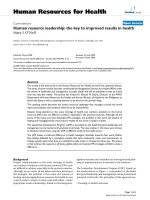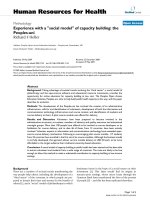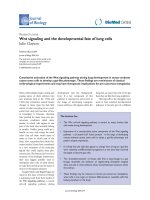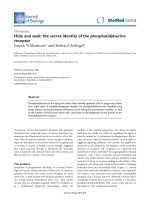Báo cáo sinh học: "Zoological detective stories: the case of the facetotectan crustacean life cycle" potx
Bạn đang xem bản rút gọn của tài liệu. Xem và tải ngay bản đầy đủ của tài liệu tại đây (961.43 KB, 4 trang )
Minireview
ZZoooollooggiiccaall ddeetteeccttiivvee ssttoorriieess:: tthhee ccaassee ooff tthhee ffaacceettootteeccttaann ccrruussttaacceeaann lliiffee
ccyyccllee
Gerhard Scholtz
Address: Humboldt-Universität zu Berlin, Institut für Biologie/Vergleichende Zoologie, Philippstrasse 13, 10115 Berlin, Germany.
Email:
In our course on evolutionary biology, we ask the students
to compare larvae, pupae, and imagines of the mealworm
beetle Tenebrio molitor with the aim of finding direct evi-
dence that these specimens represent not different species
but the stages that every individual of this hexapod species
has to pass through. The students cannot solve this prob-
lem. In spite of the most meticulous comparative morpho-
logical analysis there is no way to show that a larva and an
adult beetle belong together. Even modern molecular
markers reach their limits when only part of the life cycle is
known and we have no clue where to look for the missing
stages. Thus, the only method to resolve this issue is the
direct observation of the life cycle, including metamor-
phosis and change of shape during ontogeny.
The early stages of a complex life cycle can have a mor-
phology and an ecology that are dramatically different from
those of the adults. Accordingly, the history of zoology, in
particular during the 19th century, is full of dramatic
‘detective stories’. An example is the detection by August
Müller in 1856 [1] that the ammocoete is not a chordate
species in its own right but the larval stage of the lamprey
and thus a vertebrate. There was an even bigger sensation in
1866 when Alexander Kowalevsky [2] identified the larvae
of tunicates and revealed that ascidians are chordates and
not mollusks, and thus that these humble animals are kin to
vertebrates, including humans. Similarly, in 1870 Elie
Metschnikoff [3] showed that tornaria larvae do not belong
to an unknown echinoderm group but are the larvae of
hemichordate enteropneust worms with an adult morpho-
logy entirely different from that of sea urchins or sea stars.
These examples show that the results of these studies often
had implications that helped to clarify phylogenetic
relationships in metazoans and led to important evolu-
tionary conclusions. For instance, the metamorphosis of
ammocoete larvae to adult lampreys revealed that the
thyroid gland derives from the endostyle of the chordate gill
basket. Hence, Müller’s and Kowalevsky’s findings together
paved the way for our current view that long ago the
ancestor of humans was a sessile, filter-feeding animal. In a
recent article published in BMC Biology, Henrik Glenner and
colleagues [4] show that these kinds of investigations and
evolutionary inferences are still a valid part of modern life
sciences. They artificially induced metamorphosis in an
enigmatic crustacean group that has been known for more
AAbbssttrraacctt
The reconstruction of complete animal life cycles is sometimes a considerable problem, even
though the knowledge of the full life cycle may have far-reaching evolutionary implications. A
new study published in
BMC Biology
on artificially induced metamorphosis in an enigmatic
crustacean group that was only known from larval stages sheds new light on the evolution of
parasitism.
BioMed Central
Journal of Biology
2008,
77::
16
Published: 26 June 2008
Journal of Biology
2008,
77::
16 (doi:10.1186/jbiol77)
The electronic version of this article is the complete one and can be
found online at />© 2008 BioMed Central Ltd
than a hundred years exclusively by its larval stages. With
this study, the authors approach the solution of one of the
last major riddles of the complex biology of thecostracan
crustaceans, which has puzzled numerous zoologists over
the past two centuries.
The Thecostraca is a strange group of crustaceans that most
non-zoologists would not identify as Crustacea at all. The
adults are sessile filter feeders or parasites. The most visible
subgroup of the Thecostraca is the Cirripedia, which
includes the filter-feeding goose and acorn barnacles and
the parasitic Rhizocephala (Figure 1). With their cirri and
their often massive, calcified articulated shell, barnacles
show a morphology and lifestyle that are very different from
those of other crustaceans and of arthropods in general [5].
The parasitic forms are even more derived and sometimes
hardly recognizable as animals. The differences from other
crustaceans are also found at the molecular genetic level,
where alterations in the Hox gene complex have been
described [6]. On the basis of their appearance, early
zoologists such as Conrad Gesner or Georges Cuvier [7,8]
associated barnacles with mollusks. This view is reflected in
the German vernacular name Entenmuscheln (duck mussels).
Because of their many derived features and problematic
systematization, the Cirripedia have always attracted the
interest of researchers, among them Johann Wolfgang von
Goethe and Charles Darwin, the latter writing two large
monographs on their biology.
Barnacles, and this is true for Cirripedia and their kin in
general, are one of those groups whose phylogenetic
position has only been resolved by the recognition of their
life cycle. The details of cirripede ontogeny were for a long
time entirely unknown, although some speculations existed,
the most curious of which was that barnacles represented
early ontogenetic stages of geese, probably the Brent Goose
Branta bernicla (Figure 2) [9]. This view was based on the
shape and color of pedunculated barnacles such as Lepas,
with the stalk corresponding to the neck and the cirri to the
feathered tail of the geese and was held to explain the fact
that wooden branches covered with barnacles are often
found on the shore, while the geese are absent during
summer. According to this idea, there were trees on
northern islands that grow the barnacles as fruits on their
branches. If they are ripe they metamorphose into geese,
but sometimes branches with unripe specimens break off
and are washed to European coasts. This had the practical
implication that geese were considered as vegetarian food
suitable for consumption during Lent or on Good Friday
[10]. This story is reasonable in the sense that it puts a
number of distinct observations in a logical context and
illustrates the problem of inferences on life cycles based on
independent bits of information. The idea of ‘goosetrees’
persisted long after the real mode of reproduction of Branta
was known.
All hypotheses about relationships to mollusks or geese
came to an end when John Vaughan Thompson [11]
recognized that barnacles and their kin pass through the
nauplius stage, which is the characteristic larval type of
Crustacea [12]. Thus, Thompson’s first achievement was the
indisputable placement (as he himself stated in the title of
his contribution) of barnacles among crustaceans. But he
went even further. As noted above, the endoparasitic
Rhizocephala show the most dramatic deviation of shape
from other cirripedes. The adults form root-like networks
inside the body cavities of their crustacean hosts (for
example, the green crab Carcinus maenas), the so-called
interna, and a sack on the outer surface of the host, the
externa, containing the sexual organs and the embryos
16.2
Journal of Biology
2008, Volume 7, Article 16 Scholtz />Journal of Biology
2008,
77::
16
FFiigguurree 11
Representatives of Cirripedia. From left to right: a goose barnacle
(Thoracica, Lepadidae); an Indo-Pacific giant acorn barnacle (Thoracica,
Balanidae); and the externa of a parasitic
Sacculina
(Rhizocephala) sitting
under the abdomen of a crab.
FFiigguurree 22
Barnacles as early stages in the life cycle of geese. Left: goose barnacles
attached to a drifting log. Right: medieval view of the ‘goose tree’
producing geese of the genus
Branta
from barnacles.
(Figure 1). Nobody would associate these strange animals
with crustaceans, but again, Thompson showed that the
larval stages reveal rhizocephalan affinities [13]. They pass
through a nauplius stage, which already confirms that they
are crustaceans, but more specifically, some naupliar charac-
teristics, such as the frontolateral horns, unambiguously
indicate that they belong to the cirripedes [14].
The occurrence of a more advanced larval stage, the cypris,
with its characteristic morphology and behavior, strongly
corroborates this relationship. As is the case in barnacles,
the cypris of rhizocephalans is the stage at which the animal
finds an appropriate place to settle and begin metamor-
phosis to the adult stage. For this purpose the cypris is
originally equipped with compound eyes and with anten-
nae that are capable of bipedal walking and possess glands
producing adhesive glue [15]. The life cycle of some of these
rhizocephalans has only recently been completely under-
stood. One of the most unexpected and most interesting
features is the occurrence of an infectious stage, the
vermigon, which is injected by the late cypris into the host
organism [16]. This vermigon is a more or less undiffer-
entiated liquid-filled tube with a thin cuticle lacking any
trace of segmentation and all internal organs. Apart from
the epidermis and the chitinous cuticle, virtually nothing
indicates an arthropod relationship.
However, this is not the end of the story of unresolved or
resolved life cycles in cirripedes and their kin. With regards
to one group among the Thecostraca, we are still at the
19th-century stage of knowledge. The Facetotecta or y-larvae
were first described in the 1880s [16,17], but although they
occur virtually worldwide and apparently in many species,
only larvae, namely nauplii and cypris-like stages, have been
found and never any adults. As in the cases described above,
the specific characteristics of facetotectan nauplius and
cypris larvae indicate their kinship to cirripedes. According
to morphological and molecular evidence, Facetotecta are the
sister group to the rest of the Thecostraca [14,18] (Figure 3).
SSeennssaattiioonnaall ssoolluuttiioonnss
The work of Glenner et al. [4] provides a partial but
sensational solution to the mystery of the enigmatic life
cycle of Facetotecta. With simple but ingenious experiments
they ‘persuaded’ facetotectan cypris larvae to undergo
metamorphosis. The authors raised the larvae caught from
plankton around Japan in Petri dishes up to the cypris, the
latest stage known. To determine the species, they collected
the exuviae of the molt of the last nauplius stage. They
added defined doses of the molting hormone 20-
hydroxyecdysone (20-HE) and two other substances that
initiate metamorphosis in Cirripedia to the cypris larvae of
Facetotecta. However, only 20-HE caused metamorphosis of
y-larvae. To the surprise of the authors, they produced a
worm-like undifferentiated stage comparable to the rhizo-
cephalan vermigon. Accordingly, the authors baptized this
stage ‘ypsigon’, as a blend of vermigon and y-larvae.
This finding has several interesting implications. First of all,
the occurrence of the ypsigon strongly suggests an endo-
parasitic lifestyle of the yet unknown adult Facetotecta. And
this might explain why adults have never been detected so
far. To find out more about adult facetotectans, the question
is now which animal group forms the hosts? The wide-
spread distribution of y-nauplii indicates a quite abundant
host organism or group of organisms. If one considers a
degree of host specificity similar to that in rhizocephalans,
then it is very likely that there are a number of host species.
Another implication of the results of Glenner et al. [4]
relates to the phenomenon of convergence. As mentioned
above, it is quite obvious on the basis of morphological and
molecular data that Facetotecta is the sister-group to the
other Thecostraca and is thus not a subtaxon of Rhizo-
cephala (Figure 3). From the pattern of lifestyles in its
various subgroups it can be deduced that Thecostraca were
originally not highly derived endoparasites. Nevertheless,
different degrees of parasitism evolved independently in
various lineages, and this is perhaps not so surprising, given
that the starting point is a sessile lifestyle on various sub-
strates, including other animals such as echinoderms,
crustaceans and whales. The exciting new aspect of this
discovery is the high degree of convergent similarity of the
/>Journal of Biology
2008, Volume 7, Article 16 Scholtz 16.3
Journal of Biology
2008,
77::
16
FFiigguurree 33
Phylogenetic relationships of Thecostraca (after [14,18]). Facetotecta is
the sister-group to the rest of the Thecostraca, which comprise the
Ascothoracida and Cirripedia. Despite their phylogenetic distance from
Rhizocephala, the early postlarval stages (ypsigon) are very similar.
facetotectan ypsigon and the rhizocephalan vermigon. This
raises again the question of what kind of adult parasitic
form we should expect in Facetotecta - a structure similar to
the root-like network of Rhizocephala? If this were the case,
the surprising degree of convergence might be even higher.
Glenner et al. have made a big step towards the complete
description of the facetotectan life cycle but we are not
there yet.
After an odyssey with presumed affinities to mollusks,
plants, and geese and curious interpretations of their life
cycles, the Thecostraca arrived safely in the crustaceans and
most aspects of their partly bizarre life cycles have been
resolved. With the present knowledge, it is obvious that the
various aspects of thecostracan evolution offer very
interesting insights into the origin of parasitism, the degree
of alterations of body organizations within animals, and
into questions related to homology and convergence of
morphological structures. The study of Glenner and
colleagues reveals that classical zoological investigations at
the organismic level still have a lot to tell.
RReeffeerreenncceess
1. Müller A:
UUeebbeerr ddiiee EEnnttwwiicckkeelluunngg ddeerr NNeeuunnaauuggeenn EEiinn vvoorrllääuuffiiggeerr
BBeerriicchhtt
Arch Anat Phys Wissensch Med
1856:323-339.
2. Kowalevsky AO:
EEnnttwwiicckklluunnggssggeesscchhiicchhttee ddeerr eeiinnffaacchheenn AAsscciiddiieenn
Mém Acad Sci St Petersburg
1866,
1100::
1-19.
3. Metschnikoff E:
UUnntteerrssuucchhuunnggeenn üübbeerr ddiiee MMeettaammoorrpphhoossee eeiinniiggeerr
SSeeeetthhiieerree 11 UUeebbeerr TToorrnnaarriiaa
Z Wiss Zool
1870,
2200::
131-144.
4. Glenner H, Høeg JT, Grygier MJ, Fujita Y:
IInndduucceedd mmeettaammoorrpphhoossiiss
iinn ccrruussttaacceeaann yy llaarrvvaaee:: ttoowwaarrddss aa ssoolluuttiioonn ttoo aa 110000 yyeeaarr oolldd rriiddddllee
BMC Biol
2008,
66::
21.
5. Anderson DT:
Barnacles: Structure, Function, Development and
Evolution.
London: Chapman & Hall; 1994.
6. Deutsch JS, Mouchel-Vielh E, Quéinnec É, Gibert J-M:
GGeenneess,, sseegg
mmeennttss,, aanndd ttaaggmmaattaa iinn cciirrrriippeeddeess
In
Evolutionary Developmental
Biology of Crustacea
. Edited by Scholtz G. Lisse: Balkema;
2004:19-42.
7. Gesner C:
Gesneri redivivi, aucti et emendati tomus IV. Et ultimus.
Oder Vollkommenes FischBuch.
Frankfurt am Main: Wilhelm
Serlins; 1670.
8. Cuvier G:
Le Régne Animal.
Vol. II. Paris: Deterville; 1817.
9. Moray R:
AA rreellaattiioonn ccoonncceerrnniinngg bbaarrnnaacclleess
Phil Trans R Soc Lond
1677/1678
1122::
925-927.
10. Hulme FE:
Myth-Land
. London: Brampton; 1886.
11. Thompson JV:
OOnn tthhee cciirrrriippeeddeess oorr bbaarrnnaacclleess;; ddeemmoonnssttrraattiinngg tthheeiirr
ddeecceeppttiivvee cchhaarraacctteerr;; tthhee eexxttrraaoorrddiinnaarryy mmeettaammoorrpphhoossiiss tthheeyy
uunnddeerrggoo,, aanndd tthhee ccllaassss ooff aanniimmaallss ttoo wwhhiicchh tthheeyy uunnddiissppuuttaabbllyy
bbeelloonngg
Zoological researches, and Illustrations; or Natural History
of nondescript or imperfectly known animals.
1830
11,,11,,IIVV::
69-82.
12. Scholtz G:
EEvvoolluuttiioonn ooff tthhee nnaauupplliiuuss ssttaaggee iinn mmaallaaccoossttrraaccaann ccrruuss
ttaacceeaannss
J Zool Syst Evol Res
2000
3388::
175-187
13. Thompson JV:
NNaattuurraall hhiissttoorryy aanndd mmeettaammoorrpphhoossiiss ooff aann aannoommaa
lloouuss ccrruussttaacceeoouuss ppaarraassiittee ooff
CCaarrcciinnuuss mmaaeennaass
,, tthhee
SSaaccccuulliinnaa
ccaarrcciinnii
Ent Mag Lond
1836,
33::
456.
14. Høeg JT, Lagersson NC, Glenner H:
TThhee ccoommpplleettee ccyypprriiss llaarrvvaa aanndd
iittss ssiiggnniiffiiccaannccee iinn tthheeccoossttrraaccaann pphhyyllooggeennyy
In
Evolutionary Develop-
mental Biology of Crustacea
. Edited by Scholtz G. Lisse: Balkema;
2004:197-215.
15. Glenner H, Høeg JT:
AA nneeww mmoottiillee,, mmuullttiicceelllluullaarr ssttaaggee iinnvvoollvveedd iinn
hhoosstt iinnvvaassiioonn bbyy ppaarraassiittiicc bbaarrnnaacclleess ((RRhhiizzoocceepphhaallaa))
Nature
1995,
337777::
147-150.
16. Hensen V:
ÜÜbbeerr ddiiee BBeessttiimmmmuunngg ddeess PPllaannkkttoonnss ooddeerr ddeess iimm MMeeeerr
ttrreeiibbeennddeenn MMaatteerriiaallss aann PPffllaannzzeenn uunndd TThhiie
erreenn
Bericht der Kom-
mission zur wissenschaftlichen Untersuchung der deutschen Meere
1887,
55::
1-108.
17. Hansen HJ:
DDiiee CCllaaddoocceerreenn uunndd CCiirrrriippeeddiieenn ddeerr PPllaannkkttoonn EExxppeeddii
ttiioonn
Ergeb Plankton-Expedit Humboldt-Stift
1899,
22::
1-58.
18. Perez-Losada M, Høeg JT, Kolbasov GA, Crandall KA:
RReeaannaallyyssiiss
ooff tthhee rreellaattiioonnsshhiippss aammoonngg tthhee CCiirrrriippeeddiiaa aanndd tthhee AAssccootthhoorraacciiddaa
aanndd tthhee pphhyyllooggeenneettiicc ppoossiittiioonn ooff tthhee FFaacceettootteeccttaa ((MMaaxxiillllooppooddaa::
TThheeccoossttrraaccaa)) uussiinngg 1188SS rrDDNNAA sseeqquueenncceess
J Crust Biol
2002,
2222::
661-669.
16.4
Journal of Biology
2008, Volume 7, Article 16 Scholtz />Journal of Biology
2008,
77::
16









